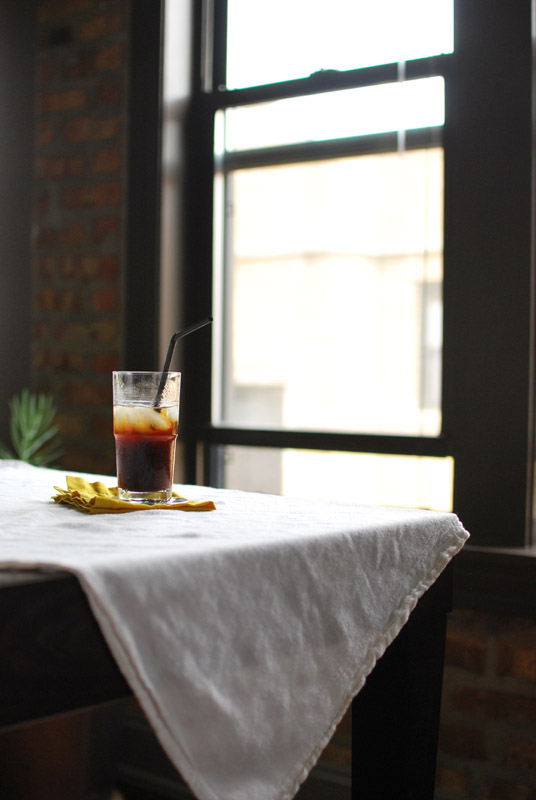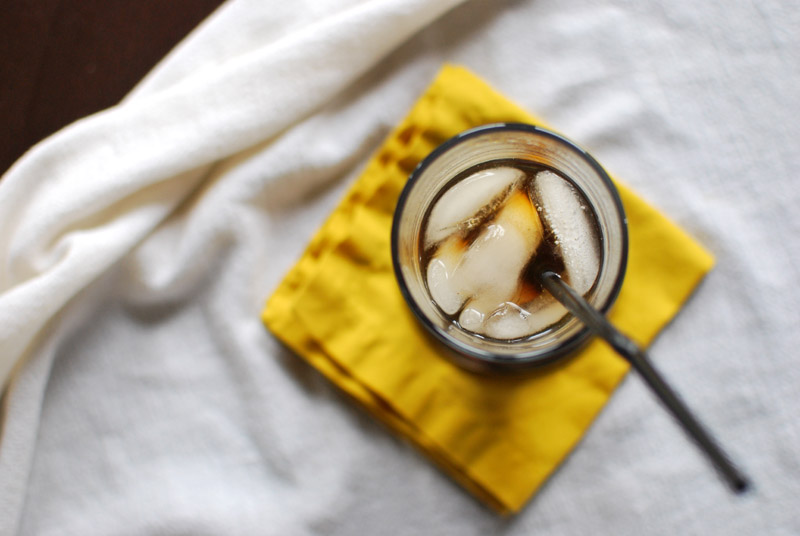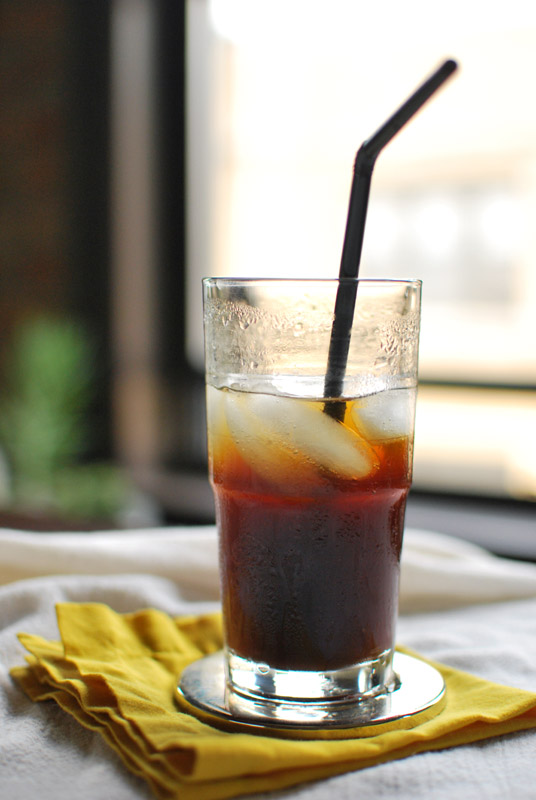I never used to like coffee. It was too bitter, had too much of a burnt-toast quality, and more often than not was served hot enough to scald my tongue into a senseless stupor for a day or so. Pass, thank you very much.
Coffee was never a big deal in my parents’ house, either. Yes, my dad would dutifully set up the machine each night on a timer, and he and my mom would each have a cup or so (my mom invariably losing hers around the house a hundred times each morning), but half the pot would later get poured unceremoniously down the drain. Coffee came pre-ground in large canisters, and whole beans were a completely foreign thing, probably only for much fancier pants than us.
During my time working at a large-scale event planning agency, however, I began to notice a different attitude towards the drink. To be sure, it was still primarily a caffeine-delivery-system, but the people there had opinions about it. I don’t actually recall a coffee maker in the office, oddly enough. Instead, cups from CC’s Coffee House, the local coffee chain of choice, filled the trash cans and crowded the desks. A strange engine-oil-type container of Cool Brew waited in the fridge in case someone just wanted a plain coffee. Starbucks, though not exactly verboten, was looked upon as a last-ditch option, unless it came in tiny cans or bottles to keep on hand for emergencies. “Maxwell House” and “Folgers” became filthy, dirty words.
Faced with such convictions, I could only hold out as the lone coffee-abstainer for so long. I cut my teeth first on the saccharine Starbucks Doubleshot, then added splashes of Cool Brew when I started to find it too syrupy. I graduated to CC’s Mochasippi, which tastes far better than the silly name implies (and is still mandatory when I visit New Orleans). Eventually, I began taking my coffee black, and even began enjoying the occasional espresso. I formed my own prejudices about certain brands of coffee and certain coffee shops. I later became acquainted with a French press, and learned to insist on whole beans. My pants became fancy.
But as much as I relish a well-crafted cup of coffee, made with just-ground beans and plunged lovingly in the French press, most mornings I just can’t be bothered. It’s too fussy, especially when, you know, I haven’t had my coffee yet. In recent years, I’ve developed a foolproof system for delivering a great cup of coffee every morning, with hardly any more trouble than my parents go to with their automatic machine. It goes like this:
1. Open fridge.
2. Remove coffee concentrate.
3. Splash a bit into a cup.
4. Add water.
5. Microwave (optional).
6. Profit.
Did you notice the part where I don’t have to grind beans, wait more than a minute, wash anything, or use my brain? Oh, yes.
The key is something that New Orleanians have apparently been doing for ages: cold-brewing coffee. You may have heard of this method, either in the New York Times, or on any number of blogs. It involves mixing ground coffee with cold water, then giving it an overnight rest. In the morning, strain and enjoy. The science behind it is solid, and the cold extraction method leaves you with a highly-flavorful coffee that doesn’t lose its edge or become bitter like hot-brewed coffee does in painfully few minutes.
My variation is in batch size and concentration; I make a whole pound of coffee at a time, which produces an ungodly amount of highly concentrated coffee that’s far more potent than any espresso. Yes, it becomes a little dull over time, but it still beats the heck out of Sanka, and it’s just as fast.
I really don’t remember where I originally found the recipe, but I came across it 6 or 7 years ago, and have used it more or less ever since. These days, there’s always a bottle in my fridge. The weather’s finally warmed up enough for me to enjoy it cold in a glass, the way God intended, but in the winter it does just as well warmed up in my favorite mug.
Aside from drinking it, the inky stuff finds other uses in my kitchen. I’ve added a shot into the liquid for braising beef or pork, or into pots of beans or rich soups; and need I tell you that used instead of vanilla, it will make your brownies or chocolate cakes absolutely sing. Add a splash to ganache and make mocha truffles. Use your imagination; you’ll find other uses.
My go-to coffee to use for this is a blend with chicory, and, yes, it comes pre-ground. Please don’t tell anyone. Sadly, my grocery has just stopped carrying it, so I’ll have to experiment with new types and report back. But whatever sort of coffee you use, just make sure it’s a medium grind. You’ll understand why if you ever try to strain off an entire pound of super-fine espresso grind.
Make each cup of coffee to taste, starting with less concentrate than you think, and adding more as you see fit. Stirred into milk, it’s the best café au lait you’ll ever have, cold or hot. Mix it with sweetened condensed milk for a Vietnamese coffee. Pull out your blender and whizz together a pick-me-up on some hot afternoon. But don’t even try the recipe unless you’re ready to keep it in your fridge forevermore, because this stuff is life-changing. Your pants have been warned.
Coffee Concentrate
Makes 10 cups
I make batches of this every 2 weeks or so, and funnel it into empty screw-top wine bottles to keep in the refrigerator. No matter how carefully or how much I strain it, it always ends up with a little bit of sediment in the bottom, so be aware of that when drinking the last few dregs. Use either stainless steel or glass containers for this recipe, because the concentrate will stain the dickens out of anything. Also, make sure the water you use for this tastes good, because no amount of good coffee can cover up the taste of bad water.
1 pound coffee, in a medium grind
10 cups cold water, filtered if necessary
1 three-fingered pinch salt (trust me)
1. In a large, non-reactive bowl, combine the coffee, water, and salt, whisking gently to wet all the grounds. Cover the bowl, and let stand at room temperature overnight, or about 12 hours.
2. The next day, strain the coffee through a fine mesh strainer into another large non-reactive bowl. Let the grounds drip until you get tired of waiting, then discard. Rinse the strainer, and line with a triple layer of cheesecloth (or use instead an extremely fine mesh strainer), and re-strain the concentrate. Strain as many times as you have patience for; very fine sediment will strain best if the concentrate is allowed to settle for 30 minutes or so between straining.
3. Funnel the concentrate into non-reactive containers of choice, and refrigerate.
4. To make coffee, pour a tablespoon of concentrate into a mug or glass, and top off with water or milk, leaving a little room. Taste. If you prefer it stronger, add more concentrate, adjusting as necessary. For hot coffee, microwave for 1 to 2 minutes. For iced coffee, um, add ice.







I have been following your blog on and off and when I saw this recipe I just had to try it. As I type it is brewing in my fridge! Can’t wait to try it! Thanks for all the great ideas.
Missy: Fantastic! I pretty much need to have this stuff in my fridge at all times; caffeine emergencies are unacceptable. Hope you enjoy it!